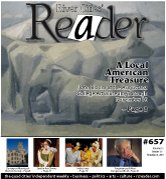 John
Bloom was a master of lines. Drawing directly from everyday life, he
transformed his observations with a skillful economy and nuance that
can only come from long experience and total observation. Even in his
lithographic printmaking, his subtle and beautifully lighted tones
were created by a multitude of lines. In his paintings, his linear
preparations paid off in a painting style that grew progressively
lighter, almost effortless.
John
Bloom was a master of lines. Drawing directly from everyday life, he
transformed his observations with a skillful economy and nuance that
can only come from long experience and total observation. Even in his
lithographic printmaking, his subtle and beautifully lighted tones
were created by a multitude of lines. In his paintings, his linear
preparations paid off in a painting style that grew progressively
lighter, almost effortless.
His sparkling drawings, lithographs, and paintings are on display at the Augustana College Art Museum (in Centennial Hall) until November 10.
Bloom was born in 1906 and grew up drawing cowboys and soldiers. During the Depression, his art attracted the attention of Grant Wood, who invited him to attend his new art colony in Stone City, Iowa. They worked together on various mural projects around Iowa, and Bloom worked on several Works Progress Administration murals. It was in Stone City that Bloom met a young artist chipping stone from her sculpture. They later married and had three boys together. Her name was Isabel, and she became famous for her cast sculptures.
John went to work for the Rock Island Arsenal and design firms during World War II and continued painting in his spare time. But after he retired in 1969, he pulled out his old sketchbooks and returned to his art full-time. He got a boost when he won the top prize at a juried regional exhibit at the Davenport Museum of Art in 1986.
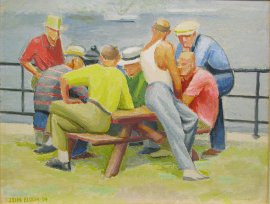 Then,
one day in the late 1980s, while out on one of his many walks, he met
Dave Losasso, who owned the Mississippi Fine Art Gallery, and who
loaned most of the work for the current Augustana exhibition. Losasso
suggested that he try lithography and set him up at the printmaking
studio at St Ambrose, where Bloom started turning his drawings into
prints. Bloom still continued painting and received some commissions
for murals inside banks and various buildings in the area, and he
blossomed into a famous area artist. In 2002, he passed away at the
age of 96. I spoke with him a few times, and he had a soft voice,
exact and relaxed, just like his lithographs.
Then,
one day in the late 1980s, while out on one of his many walks, he met
Dave Losasso, who owned the Mississippi Fine Art Gallery, and who
loaned most of the work for the current Augustana exhibition. Losasso
suggested that he try lithography and set him up at the printmaking
studio at St Ambrose, where Bloom started turning his drawings into
prints. Bloom still continued painting and received some commissions
for murals inside banks and various buildings in the area, and he
blossomed into a famous area artist. In 2002, he passed away at the
age of 96. I spoke with him a few times, and he had a soft voice,
exact and relaxed, just like his lithographs.
His early influence in painting came from Cezanne, who used color as a means of modeling and looked for the essential structure of nature in the cone, the sphere, and the cylinder. These forms show up in Bloom's thick paintings from the 1930s and '40s. With Two Cows, in oil, each part is produced by masses of paint, like thick Cubistic blocks, which emerge from the background rocks and seem to swell out and crowd the whole space.
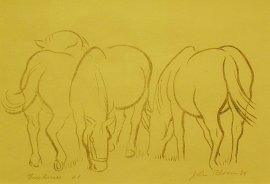 But
his own style was approaching in two little colored-pencil sketches
he made before the painting. In these he revealed every form and
space by his lines, with a realistic, light, and beautiful touch.
But
his own style was approaching in two little colored-pencil sketches
he made before the painting. In these he revealed every form and
space by his lines, with a realistic, light, and beautiful touch.
His early Cezanne painting phase is also evident in his solid and sensitive oil from 1938 called Seining for Minnows. We see two men, one standing and the other squatting, each holding on to one end of a purple net. Near them are three buckets, where they would put the minnows they caught. Behind them the water is in shades of blue fading back into the distance. And beyond this in space are some indistinct hills, more like forms filling in the air. Neither man casts a shadow, just as in Japanese wood-block prints. And the darkened curves of the faces and clothes, the distance in the water, and the shape of the hills are created by modulations of colors - white to pinks, blues to mauves, and purples to olives.
Next to this painting are a dozen little black-and-white drawings and thumbnail sketches that Bloom made before the final. Not all artists do this research; some just start right out and paint and change the image in the making. Here we can see Bloom refining his mental picture, altering the shapes and the forms of the different elements, trying out darks and lights in individual areas, and playing with the balances of tone for his painting. He added a few small studies of the crouching man with his arms further out or close by his body. In others, he reduced the whole composition down to its basic geometric forms of circles and thrust lines that would guide the eye around the composition, so the audience wouldn't be tangled up in any one place, like the minnows in the net.
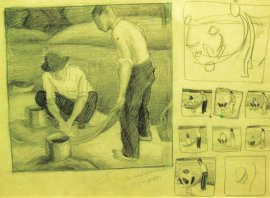 And
then, after all these preludes, he made a thin color painting of the
Minnows
in gouache, which is like watercolor but opaque. This study is very
close to the final, a dress rehearsal. He made all his choices in the
preliminary rounds, and the strength of the final work is the result.
In the end, he made it all seem easy.
And
then, after all these preludes, he made a thin color painting of the
Minnows
in gouache, which is like watercolor but opaque. This study is very
close to the final, a dress rehearsal. He made all his choices in the
preliminary rounds, and the strength of the final work is the result.
In the end, he made it all seem easy.
We can see the progression in his painting style in one of his later oils called Winter. It's of a large house in a neighborhood covered in snow with a little boy pulling his sled in the street below. The scene is viewed from the third story of a house. Large areas are painted in muted flat colors. A few subtle tufts of heavier paint appear for contrast. Here he shows the light on the snow and the crisp coolness of the air. Everything is quiet, like an early winter morning. This is the style of his later murals, whispers of paint, soft like his lithographs.
Another side of his work came from the strong influence of Matisse of the lyrical line, and this can be seen in his excellent little 5 Minute Figure Sketch, of a reclining model from 1928, all in lines. Simple and elegant, all the proportions are perfect and sure. We get the sense of the light falling over the back of the model by the way he drew the lines heavy or light, to show the implied shading. No tones, just graceful lines full of life. Very few artists can do this. His ability to "carve" out a real figure sitting in real space onto a flat piece of paper was one of his greatest strengths.
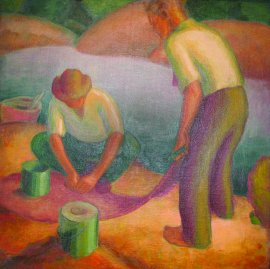 Similar
in style and just as wonderful is the little drawing called
Three Horses, very lightly
drawn. The animals' bodies are skillfully shaped with their rounded
shoulders and necks, and perfectly formed legs. We get a strong
feeling of the life of each animal, breathing and lyrical, their
movement caught in a split second of time. The entire drawing has
only a few elegant lines, all from observation, and all hitting the
mark.
Similar
in style and just as wonderful is the little drawing called
Three Horses, very lightly
drawn. The animals' bodies are skillfully shaped with their rounded
shoulders and necks, and perfectly formed legs. We get a strong
feeling of the life of each animal, breathing and lyrical, their
movement caught in a split second of time. The entire drawing has
only a few elegant lines, all from observation, and all hitting the
mark.
Bloom's drawing ability fit perfectly into lithography, in which the artist draws an image with a soft, sticky pencil on a smooth limestone surface. Darks are made by a repetition of line. After lightly biting the stone with acid to expose the drawing, ink is rolled across, and dozens of images can be pulled. An edition can be drawn and printed in the same day.
One of Bloom's finest lithographs - and they are all excellent - is called Picking Corn. We can clearly see two horses in white with black harnesses across them, two rich, dark forms of the cart behind the horses, a man in dark overalls with a white shirt leaning over, and rows of corn stalks in intricate black-and-white forms. The space reads flat on the left with the corn and moves far back on the right, overlooking the autumn fields. He has the whole world here - earth, life, space, and a particular time, all seen in an instant.
 On
a long wall of the gallery are several lithographs of the people of
Davenport by the river, touched with insight, empathy, and a gentle
humor. These were turned from drawings into prints during his last 30
years. He drew them first in his sketchbooks watching people reading
newspapers, playing checkers, fishing, riding bikes, or just looking
out over the river at the ferry boats. If we step back and look,
everything turns into beautiful abstract shapes and shades, full of
movement across the page, a kind of syncopated music of dark and
light areas, backed by the continuous rhythm of fence posts or the
arches of the bridge in the distance. He frequently paired black and
white areas and forms - the quiet, darker areas right next to the
soft, lighter ones - or he balanced two black and white figures in
open spaces opposite each other. He made his tones with lines -
lots of lines.
On
a long wall of the gallery are several lithographs of the people of
Davenport by the river, touched with insight, empathy, and a gentle
humor. These were turned from drawings into prints during his last 30
years. He drew them first in his sketchbooks watching people reading
newspapers, playing checkers, fishing, riding bikes, or just looking
out over the river at the ferry boats. If we step back and look,
everything turns into beautiful abstract shapes and shades, full of
movement across the page, a kind of syncopated music of dark and
light areas, backed by the continuous rhythm of fence posts or the
arches of the bridge in the distance. He frequently paired black and
white areas and forms - the quiet, darker areas right next to the
soft, lighter ones - or he balanced two black and white figures in
open spaces opposite each other. He made his tones with lines -
lots of lines.
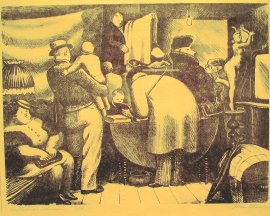 Another
litho is called Tennis.
Three men are watching another playing tennis against an unseen
opponent. The court looks small, and the spectators seem tired from
playing. But the drawing
is free, compact, and exact, all at the same time. We know what's
happening, yet there is still a gentle mystery. He can hit every
point with ease, like the tennis player.
Another
litho is called Tennis.
Three men are watching another playing tennis against an unseen
opponent. The court looks small, and the spectators seem tired from
playing. But the drawing
is free, compact, and exact, all at the same time. We know what's
happening, yet there is still a gentle mystery. He can hit every
point with ease, like the tennis player.
A display window in the gallery shows a few sketchbooks that John drew while still in high school, and other sketchbooks from his 20s and 30s. The guards change the pages every day, revealing a new layer of this artist.
There's much to see. Don't forget to look well, because he can teach us a lot.
For more information on the Augustana College Art Musuem, visit (http://www.augustana.edu/artmuseum/).










